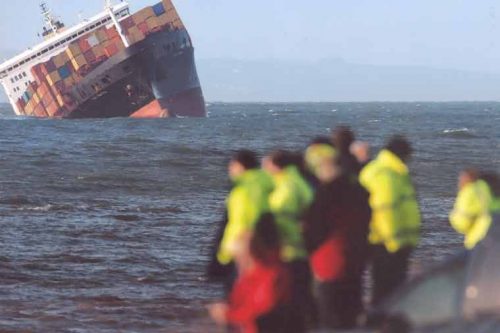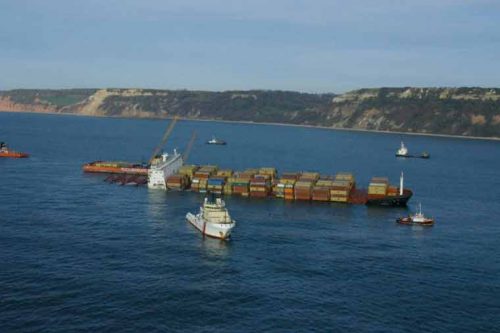NEWS FEED

Consider this nightmare scenario – a huge container ship heading down the English Channel is severely damaged in a storm and forced to come ashore on Dorset’s famous Jurassic Coast – a World Heritage Coastline.
The major maritime incident put the coastal village of Branscombe firmly on the map and sparked a major international multi-agency recovery and salvage operation that took two and a half years to complete.
The drama began on 18 January, when the Napoli, a 62,000 tonne container ship enroute from Antwerp to Durban, South Africa, ran into a violent storm off Britanny. The ship put out a distress call after suffering ‘catastrophic damage’ to its hull. All 26 crew were airlifted to safety in a rescue operation co-ordinated by UK coastguards.
Force 11 northerly winds made it impossible for the vessel to shelter along the French coast, so the French government asked the UK government if the crippled ship could be towed across the Channel into UK waters. The Napoli was still afloat, but listing badly.
The ship was carrying 2,300 containers and 3,800 tonnes of oil. Its assorted cargo included explosives, fertiliser, weedkiller, car engines, chocolate, Polish bibles, vodka, shampoo, wine, coffee, perfume, dog biscuits and frozen ducks.
With the storm showing little sign of abating, the UK government gave permission for the stricken vessel to be brought into territorial waters. The initial plan was to tow the ship to Dorset’s Portland harbour, but because of the risk of it sinking, it was decided to bring the vessel into the sheltered waters of Lyme Bay where it could be beached near Sidmouth.

So on the morning of 20 January, the Napoli finally came ashore off Branscombe, the crack in her hull clearly visible near the ship’s bridge. Within hours, the latest ‘visitor’ to Dorset’s Jurassic Coast was front page news and thousands sightseers descended on the picturesque village to get a close-up look of the vessel.
As the sheer scale of the operation became apparent, the government launched its National Contingency Plan for Marine Pollution. The Maritime & Coastguard Agency established a Salvage Control Unit (SCU) to deal with the salvage operation and a Marine Response Centre (MRC) to manage the pollution response at sea.
Meanwhile, an Environment Group was hastily convened to minimise the environmental impact of incident and help co-ordinate a land-based response. Organisations represented on the group included the Environment Agency, Natural England, Health Protection Agency, Centre for Environment, Fisheries and Aquaculture Science (CEFAS) and the RSPB.
The decision to deliberately beach the stricken ship off East Devon was taken by the Secretary of State’s Representative for Maritime Salvage and Intervention (SOSREP). An inquiry later concluded it was a correct decision as it almost certainly averted a ‘pollution catastrophe’ in the Channel.
Not all sightseers were happy to simply look at the beached vessel. Containers lost from the deck of the Napoli started being washed ashore prompting the arrival of hoards of people from all over the UK intent on scavenging cargo. Boxes of shampoo, wine barrels and even BMW motorcycles, still in their packing crates, were manhandled off Branscombe beach by an army of modern day ‘wreckers.’

The disruption and disturbance to the normally peaceful village of Branscombe was made worse by narrow country lanes that soon became clogged with vehicles arriving to remove valuable items of cargo from the container strewn beach.
Media interest reached fever pitch with tv crews and journalists bombarding the SOSREP, Environment Group, Maritime and Coastguard Agency (MCA) and police for interviews. To cater for the unprecedented level of interest, an international media event was held in Sidmouth the day after the grounding where journalists’ interest switched from potential pollution by oil to the ransacking of cargo. Chair of the Environment Group, Julian Wardlaw, from the Environment Agency, gave 11 media interviews in two hours including two in French.
First priority was to remove 3,800 tonnes of diesel, bunker fuel and hydraulic oil from the Napoli. The ship had lost approximately 10 tonnes of oil shortly after arriving off Branscombe Beach, but favourable winds blew most of it offshore. The cargo absorbed a lot of oil – dog biscuits lost from one of the ship’s damaged containers, proved particularly effective.
Salvage experts worked round the clock to remove oil from the vessel. Divers drilled into the hull and emptied oil from all of the ships fuel tanks within eight weeks of beaching. The salvage operation was helped by fine weather.
Inevitably, some oil did escape and over the following weeks 1,000 seabirds were collected and sent to the RSPCA for treatment. 600 were later released after being cleaned and nursed back to health. An estimated 302 tonnes of oil was lost during the incident. Most was carried eastwards and was washed up on local beaches – some up to 20 miles away.
A total of 114 containers were lost from the deck of the ship. 80 were washed ashore. Most were later recovered.
The Environment Agency and CEFAS carried out monitoring throughout the salvage operation to check for signs of pollution and assess the environmental impact in the sea and surrounding coastline. Cargo from broken containers, especially lighter plastics, were carried on tides as far as East Sussex.
The second stage of the salvage operation involved the removal of containers from the Napoli. A full assessment was made of the cargo that included 159 containers of dangerous goods. Large cranes were brought over from Holland on a barge. The containers were then taken by barge to Portland for assessment, recycling or disposal. Attention turned to the ship once all the oil and cargo had been removed.
By the summer of 2007 it was decided to try to re-float the Napoli. Although it was successfully re-floated, the vessel was too badly damaged to be towed so it was dismantled instead using explosives to separate the bow section from the stern.
The bow section was towed to Harland and Wolff shipyard in Belfast for final dismantling while the stern was left at Branscombe to be dismantled in situ. The wreck was battered by winter storms in 2008, but was eventually cut up and taken by barge to Rotterdam.
A scan of the seabed showed that by July 2009, every last trace of the Napoli had been removed. The whole operation had taken two and a half years. Total cost of the incident was in excess of £120 million.
The multi-agency Environment Group was later praised by the Napoli’s owners and other responders for its effectiveness and reactive approach.
Reflecting on events of 10 years ago, Julian Wardlaw from the Environment Agency who chaired the Environment Group said, “The grounding of the Napoli was such an unusual event we had to be very innovative. We were fortunate in that the Environment Group was well supported by its partners, especially the MCA, Natural England and Public Health England. It meant, in the first two weeks, we could meet almost continually to help manage the incident as it unfolded.”
At a subsequent inquiry into the Napoli, Julian Wardlaw said he supported the decision to deliberately ground the stricken container ship off the East Devon coastline describing it as the ‘least worst option.’
Hugh Shaw, the current Secretary of States Representative (SOSREP) said, “Fortunately, shipping incidents as serious as the Napoli are rare within UK waters. The scale of the response and resources required to salvage this ship were immense.

“The strategy was unusual in that we deliberately grounded the ship in Lyme Bay to mitigate against a potentially far more serious situation. Once the vessel was in the shallow, sheltered waters of Lyme Bay, the salvage operation was at infinitely more manageable.”
Hugh Shaw added, “As with all shipping incidents in UK waters, we make every effort to protect the environment, and the Napoli was no different. Failure to take action would have led to a significant risk of the vessel sinking in the open seas of the English Channel which could have led to long term environmental consequences as well as navigation safety issues. Importantly there was no loss of seafarers’ lives during the incident.”
The Napoli set a benchmark in maritime incidents and is used by the MCA in training exercises to demonstrate how best to respond to maritime and coastal emergencies and safeguard the public and environment.
In total, the recovery and salvage operation lasted 924 days.
“Thankfully, no UK shipping incident has come remotely close to this timescale in the 10 years since Napoli,” said Hugh Shaw.
“The grounding of the MSC Napoli was arguably a turning point that prompted a change in the way such incidents are dealt with by the authorities. Initial confusion over who’s responsibility was what, led to the authorities playing catch-up to some extent as thousands of people descended on Branscombe to pick through the containers’ contents as they were washed ashore,” said Councillor John Hart, Leader of Devon County Council.
Devon County Council helped fund a special report that formed the basis for action and lobbying to ensure local authorities were better placed to deal with any future shipping incidents.
And it was this work, by the Local Government Association, that played a vital part in the development of a ‘Cross-Channel Declaration on Shipping Incidents’ to reduce the risk of acute pollution events. Devon County Council took a lead role in helping secure the signatures of this declaration by many coastal authorities in England and France.
“Declarations and changes in policy do not mean incidents like the MSC Napoli will not happen again, but the debate that followed means emergency services and local authorities are now better placed to respond quickly and with greater efficiency. The joint working today between members of the Local Resilience Forum are testimony to that cooperation and have been tested numerous times since with emergencies such as flooding,” said Councillor Hart.
“On the 10th anniversary, it is also a time to remember the many local volunteers who, alongside the local councils and agencies, worked hard to return this iconic stretch of coastline back to its former beauty for the enjoyment of everyone,” he added.








